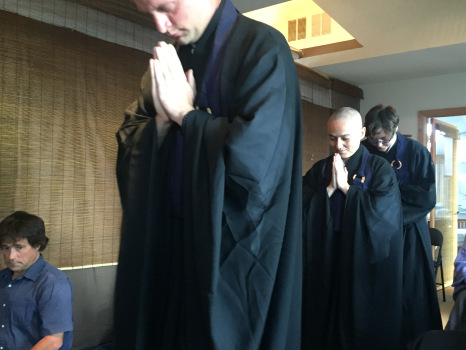
The Zen Path Of Priest Ordination
Some people are called internally to extend their commitment to the practice of Zen Buddhism and service to others through the process of formal priest ordination. Zen Priests serve as carriers and protectors of the dharma; they perform ceremonies, pastoral counseling, offer dharma teachings, and they make a lifelong commitment to serve the teachers and the sangha. Zen priests should be models of the Buddha’s teachings. The process of priest ordination includes many years of dedicated meditation practice, intimate guidance by the teachers, refinement of personality, development of ethical behavior, and education of Buddhist philosophy and ceremony.
Ordination Process
- Becoming a Buddhist: Taking Jukai, receiving the 16 Bodhisattva precepts, committing to a teacher.
- Postulancy: a one year period of discernment that includes intensified training and increased service to the sangha and teachers. Attend all retreats and courses. A postulant is asked to look at their life and their attachments to worldly engagements and see if they are ready to make the commitment of time and life direction required for ordination.
- Novice Ordination: a 3-5+ year process of discernment that includes intensified training and a strong commitment to the sangha and teachers. Attend all retreats and courses. Postulants and novice priests are encouraged to focus on their training and keep external obligations to a minimum, such as relationships, financial commitments, educational commitments, lengthy vacations, etc. This is a period of time in which the novice and their seniors examine the novice’s intentions and behavioral patterns to decide if a person is appropriate to represent the priesthood.
- Residential Training: at least 3 years. This is an important component of priest training, even if a person desires to largely serve as a temple priest or more in the world. Daily ritualized training in a tight residential container not only deepens a person’s meditation practice and embodiment of ceremonies in a way that is unlikely to happen otherwise, but a person’s interpersonal skills and underlying psychosocial developmental gaps are brought to light and developed.
- Zen Priest Ordination: the novice and teachers may decide that ordination is appropriate.
- Full Zen Priest: Common in the U.S. and consistent with the Soto Zen Buddhist’s Association (SZBA) and Zen Center of Los Angeles, a Full Zen Priest is a priest who has been given Dharma Transmission. This level of priest is a Sensei and can give jukai, have students, and run a temple/center and sangha independent of their teacher.
Zen priests are not necessarily monastics (monks & nuns), though a significant period of time spent in residential training is required/recommended. Priests may have romantic relationships, own houses, have jobs, have spouses and kids, and function in the world much like lay practitioners. However, their priority is always the Three Treasures: the Buddha, the Dharma, and the Sangha. Their commitment includes following the direction of the teachers and dropping everything if called to do so. Priests may facilitate meditation groups under the guidance of the teachers.
The priest ordination process described above is the standard progression; there is room for individual paths to be accommodated (ex: someone has previous residential training or a significant amount of time practicing Zen as a lay person). See the RESOURCES page for suggested readings on Zen Training and Priest Training (monasticism section). It is recommend that those interested in priest ordination have discussions with our priests and novices, and ask for priest-specific readings from the senior priests.

